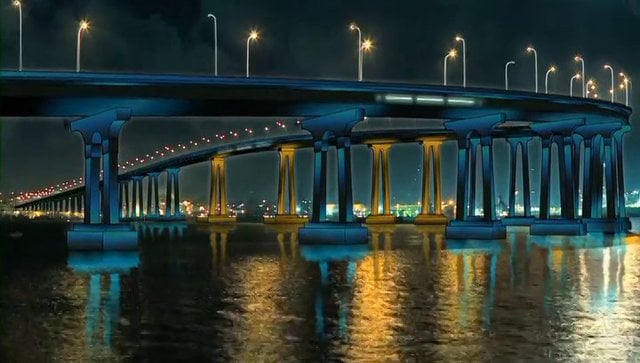The light versus lives fight has abetted at least for now, thanks to outreach efforts from the Port of San Diego.
On Tuesday, Marshall Merrifield, Chair of the San Diego Port Commission attended Coronado’s city council meeting to explain the commission’s plans to illuminate the San Diego Coronado Bridge with LED lights, and to tamp down a firestorm that had erupted in Coronado, led by the Coronado San Diego Bridge Collaborative for Suicide Prevention, over the $8 million project .
The group had launched a Lives Before Lights (#livesbeforelights) campaign to install a net under the bridge before any money was spent on the lighting project.
Since the bridge opened in 1969 there have been some 375 deaths and over 200 bridge closures, the group’s president Wayne Strickland pointed out.
Merrifield called the bridge “an iconic symbol that unites our region” and that illuminating it would be a “tremendous way of expression of our hopes and dreams.” He also told the council that he understood “the importance of suicide prevention [and promised to] stand by to help anyway we can.”
His outreach seemed to cool the situation and steal some of the group’s thunder. “We came with guns, but now we can all make peace,” Strickland said, referring to the Lives Before Lights fliers he had brought to the meeting.
Instead of fighting the lighting project, Strickland said that his group wanted to get involved with its planning phase and to help find a way include a net as part of the installation.
The idea to illuminate the bridge as an artistic expression began more than a decade ago. The economic implosion in 2008 caused the project to be shelved. Last year the Port Commission hit on the idea of using the Percent for Art program to finance the project. Under the 25-year old program, port tenants undertaking improvement projects, whose cost meets or exceeds $5,000,000, are required to allocate no less than one percent of the tenant improvement’s total project cost for public art. The money is earmarked for art.
Once the port’s plans became widely known, the collaborative launched a Facebook campaign to get the port to spend the money on installing a net under the bridge to prevent suicides instead.
Merrifield not only expressed sympathy for the collaborative’s efforts, he said that he had discussed the issue with Laurie Berman, Caltrans district director, and would do what he could to further the collaborative’s efforts.
Strickland embraced the offer to begin working with the Port during the design development phase. “We want to get involved,” he told the city council after listening to Merrifield.
Besides the net, there were some other concerns with the lighting project. Councilmen Mike Woiwode and Richard Bailey wanted to know how the lighting project might impact the city’s Gateway project. “We have a city project underway and it would be a good idea that we’re on the same page,” Bailey said.
The idea to include both the old toll plaza and the murals in Chicano Park in the illumination project were already under discussion, Merrifield assured the council. He and Yvonne Wise, Chief Arts Curator made it clear that they want full public input from both Coronado and Barrio Logan.
Including both communities’ signature projects might be easier than affixing a steel net to prevent suicides. Lighting the murals under the bridge and renovating the old toll booths are public art endeavors. A steel net is not. It will require another source of funding and oversight. To that end, neither the City of San Diego, the City of Coronado, or the Port of San Diego has much say. Only Caltrans can move the net project forward. For now there is only an agreement between the Port of San Diego and Caltrans to light the bridge, not to install a net. The collaborative, though, was successful in making suicide prevention part of the conversation.





